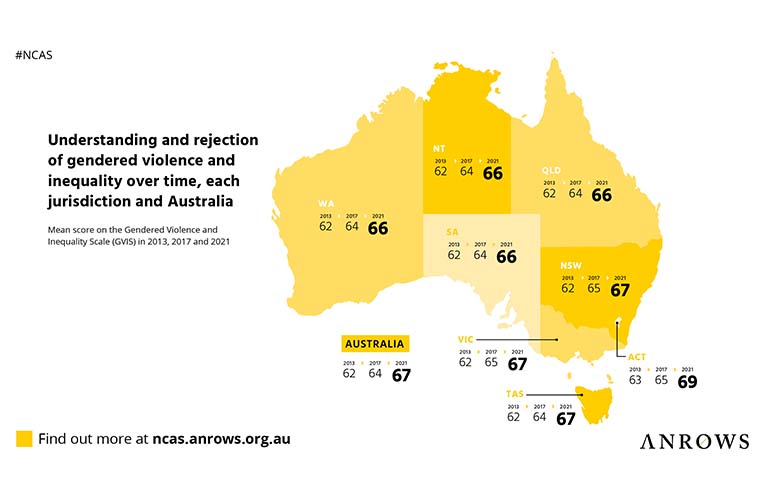
THE ‘2021 National Community Attitudes Survey (NCAS) States and Territories report’, released last week by Australia’s National Research Organisation for Women’s Safety Limited (ANROWS), found that every state and territory has improved in their attitudes towards violence against women over the last decade, despite a plateau for NSW, Queensland and Victoria since 2017.
Following on from the release of the 2021 NCAS main report on Australia as a whole, which surveyed 19,100 Australians, this sub-report breaks down the findings for each state and territory, to consider how each jurisdiction is tracking in comparison to the Australian population.
 Advertise with News of The Area today.
Advertise with News of The Area today.It’s worth it for your business.
Message us.
Phone us – (02) 4981 8882.
Email us – media@newsofthearea.com.au
The 2021 NCAS States and Territories report found that rejection of violence against women had reached a comparable level in all jurisdictions in 2021, except for the ACT.
The ACT had a significantly higher rejection of domestic and sexual violence, including sexual harassment and sexual assault, and a significantly higher trust in women’s reports of violence, compared to the rest of Australia.
The report found that since 2009 Australia has significantly improved in its understanding and rejection of violence against women.
Although improvement has occurred across all states and territories, less than half the respondents in each jurisdiction had “advanced” rejection of violence against women in 2021.
Padma Raman PSM, CEO of ANROWS, said that the 2021 NCAS States and Territories report, is the first of many sub-reports which will unpack the findings of the 2021 NCAS.
“The states and territories sub-report has shown that while positive change is occurring across Australia, there is significant room to improve understanding and attitudes towards violence against women in every state and territory,” Ms Raman said.
“The National Plan to End Violence against Women and Children 2022-2032 provides the blueprint, and each jurisdiction should take stock of their policies, frameworks, and systems, in light of the 2021 NCAS, to consider solutions to end violence against women.”
“Changing attitudes is a slow process. Significant work still needs to be done in each state and territory to change the culture that underpins violence against women.
“All jurisdictions should consider how they can continue to do so.”
Assistant Minister for the Prevention of Family Violence Justine Elliot said the NCAS gave critical insights that would help to achieve a future free from violence.
“The National Plan recognises that ending violence against women and children is everybody’s responsibility and business, and the NCAS highlights that more needs to be done to build community awareness and understanding,” Assistant Minister Elliot said.
“This is a national priority, and our government is proud to have just announced a further $589.3 million for women’s safety and implementation of the National Plan, building on the record investment of $1.7 billion through the October 2022 Budget.”
Patty Kinnersly, CEO of Our Watch, said the NCAS shows the harmful attitudes that need to be addressed.
“The NCAS findings highlight where continued effort is needed to improve people’s understanding of violence against women, and to challenge the harmful attitudes that drive gender-based violence,” Ms Kinnersly said.
“For women to be safe they must be equal, and to stop violence against women before it starts, we need to address harmful attitudes and help Australians understand that violence against women and gender equality are closely connected.”
Some notable findings from the 2021 NCAS States and Territories report:
– All jurisdictions increased in their rejection of violence against women over the longer term, despite a plateau between 2017 and 2021 for some jurisdictions (NSW, Queensland and Victoria).
– All jurisdictions improved in their understanding of violence against women and rejection of sexual assault and sexual harassment, and most jurisdictions improved in their rejection of gender inequality since 2017.
– In 2021 most states and territories had a comparable level of understanding of violence against women, and rejection of violence against women and gender inequality
– In 2021, most respondents in Australia agreed that violence against women is a problem in Australia, but significantly more NT respondents (70 percent) than other Australian respondents (38-54 percent) agreed that violence against women is a problem in the suburb or town where they live.
– More ACT respondents than Australian respondents demonstrated “advanced” rejection of domestic violence (51 percent versus 40 percent) and “advanced” rejection of sexual violence (51 percent versus 40 percent).
– People in the ACT, South Australia, Tasmania and Western Australia improved in their rejection of all aspects of gender inequality, including rejection of attitudes that undermine women’s leadership and decision-making in the workplace and in public life, which plateaued in Australia as a whole.